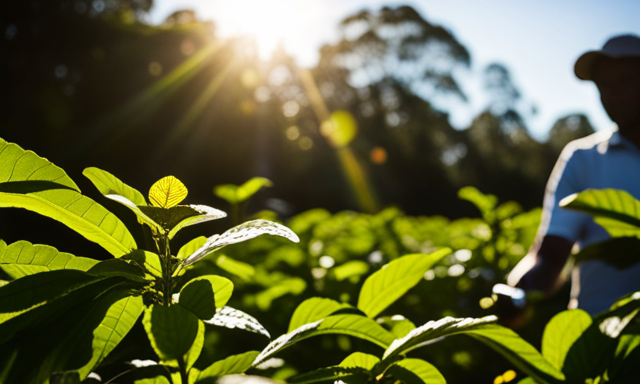Have you ever pondered what drives the lively and spirited energy of South Americans? Yerba mate acts as their source of sunlight – it’s the comforting and stimulating beverage that energizes their daily lives.
In this article, we will delve into the depths of this fascinating herbal infusion and explore what it’s made of. Yerba mate is a traditional South American beverage that originated from the indigenous Guarani people. It is made from the dried leaves and stems of the yerba mate plant, scientifically known as Ilex paraguariensis. These leaves and stems are carefully harvested and then dried using a meticulous process to maintain their flavor and aroma.
But what sets yerba mate apart is not just its ingredients, but also how it’s prepared and enjoyed. From the traditional gourd and bombilla to modern variations, there are various ways to savor this unique drink. And let’s not forget its distinct flavor profile – a delightful combination of earthiness, bitterness, and a hint of smokiness.
So, join me on this journey as we uncover the secrets of yerba mate and gain a deeper understanding of this remarkable beverage.
Key Takeaways
- Yerba mate is made from the dried leaves and stems of the yerba mate plant, scientifically known as Ilex paraguariensis.
- The yerba mate plant is a small evergreen tree native to subtropical regions of South America.
- The leaves of the yerba mate plant are the most commonly harvested part and contain a high concentration of caffeine and other beneficial compounds.
- Yerba mate undergoes a processing method that involves drying, aging, and grinding before it can be prepared and enjoyed.
History and Origins of Yerba Mate
Now, let me tell you about the fascinating history and origins of yerba mate. Yerba mate has a rich history and cultural significance in South America, particularly in countries like Argentina, Uruguay, and Paraguay. It has been consumed by indigenous tribes for centuries and later adopted by European colonizers. The drink has become an integral part of their social gatherings and traditions.
However, the popularity of yerba mate has led to environmental concerns and conservation efforts. The increasing demand for yerba mate has resulted in deforestation and habitat destruction. To combat this, organizations and farmers have started implementing sustainable harvesting practices and reforestation projects. These efforts aim to preserve the natural resources and biodiversity of the regions where yerba mate is grown.
Now, let’s delve into the yerba mate plant and harvesting process.
Yerba Mate Plant and Harvesting Process
The yerba mate plant, scientifically known as Ilex paraguariensis, is a small evergreen tree native to the subtropical regions of South America. It belongs to the holly family and can reach heights of up to 15 meters.
The leaves of the yerba mate plant are the most commonly harvested part, as they have a high concentration of caffeine and other beneficial compounds.
To ensure sustainable harvesting, methods such as selective pruning and replanting are employed to maintain the health and productivity of the plantations.
Botanical characteristics of the plant
With its leaves bursting with nutrients and its branches reaching towards the sun, yerba mate emerges as a vibrant symbol of vitality in the botanical world.
This evergreen plant, scientifically known as Ilex paraguariensis, belongs to the holly family and is native to the subtropical regions of South America. It typically grows to a height of 20-50 feet and has a dense, bushy crown.
The leaves are dark green and glossy, with serrated edges and a pointed tip. Yerba mate plants thrive in well-drained, acidic soil and require a moderate amount of sunlight to grow. They are known for their resilience, adapting to a wide range of climatic conditions.
As we delve into the subsequent section about sustainable harvesting methods, it becomes evident that the botanical characteristics and cultivation techniques of yerba mate play a crucial role in its successful cultivation.
Sustainable harvesting methods
If you want to ensure the long-term survival of this vibrant plant, you need to adopt sustainable harvesting methods that prioritize the well-being of the ecosystem. Sustainable farming methods play a crucial role in reducing the environmental impact of yerba mate production.
Here are some key practices to consider:
-
Rotational harvesting: This method involves selectively harvesting mature leaves while leaving younger ones to continue growing. By allowing the plant to regenerate, it ensures a sustainable yield and prevents overexploitation.
-
Shade-grown cultivation: Yerba mate thrives in the shade of taller trees, mimicking its natural habitat. By cultivating it under shade, we protect the soil, conserve water, and maintain biodiversity.
-
Organic fertilizers: Utilizing natural fertilizers like compost and manure instead of synthetic ones minimizes chemical runoff and soil degradation, preserving the ecosystem’s integrity.
-
Responsible water management: Efficient irrigation systems and water conservation techniques help reduce the overall water consumption during cultivation.
Implementing these sustainable harvesting methods not only safeguards the future of yerba mate but also promotes the health of the surrounding environment.
Transitioning to the subsequent section about ‘yerba mate leaves and stems’, we can explore how these sustainable practices influence the plant’s composition.
Yerba Mate Leaves and Stems
To make yerba mate, you’ll need to gather leaves and stems from the yerba mate plant. The leaves and stems of the yerba mate plant are rich in nutrients and contain various bioactive compounds. Yerba mate is known for its high antioxidant content, which helps protect the body against oxidative stress. Additionally, it contains caffeine, theobromine, and theophylline, which provide a stimulating effect. After harvesting, the yerba mate leaves and stems undergo a processing method that involves drying, aging, and grinding. This process helps to enhance the flavor and aroma of yerba mate while preserving its nutritional properties. Once prepared, yerba mate can be enjoyed traditionally by steeping the leaves and stems in hot water and sipped through a bombilla. This traditional method of preparation allows for a unique and invigorating drinking experience. Moving on to yerba mate preparation and traditional drinking methods, let’s explore the art of enjoying this energizing beverage.
Yerba Mate Preparation and Traditional Drinking Methods
When it comes to preparing and enjoying yerba mate, there’s an art to it that adds to the invigorating experience. Yerba mate brewing techniques vary across different regions, but the traditional method involves using a hollowed-out gourd called a mate and a metal straw called a bombilla.
The gourd is filled with dried yerba mate leaves and stems, then hot water is poured over it. The bombilla is used to filter out the leaves and stems while sipping the infused liquid. This process allows for multiple infusions, as the leaves retain their flavor even after several pours.
Traditional yerba mate drinking ceremonies often involve passing the gourd around in a clockwise direction, symbolizing unity and friendship.
Transitioning to the next section, the brewing techniques and ceremonies contribute to the unique flavor profile of yerba mate.
Flavor Profile of Yerba Mate
Get ready to experience the distinctive taste of yerba mate, as its flavor profile is a harmonious blend of earthy notes and subtle hints of sweetness, creating a sensory journey that will leave you craving more. The flavor notes of yerba mate can vary depending on the specific brand and preparation method. Generally, it has a robust and rich taste with a slightly bitter undertone. The earthy flavors come from the leaves of the yerba mate plant, which are dried and ground to create the tea-like beverage. To fully appreciate the flavor, it is important to choose the right brewing techniques, such as using hot water but not boiling, and allowing the yerba mate to steep for the appropriate amount of time. These methods will result in a well-balanced and flavorful cup of yerba mate. Moving on to the health benefits of yerba mate…
Health Benefits of Yerba Mate
Now that we’ve explored the flavor profile of yerba mate, let’s delve into its health benefits and nutritional properties.
Yerba mate contains a variety of vitamins and minerals, including vitamin C, vitamin B complex, and potassium, making it a nutritious choice for daily consumption.
Additionally, yerba mate is rich in antioxidants, which help protect the body against oxidative stress and reduce the risk of chronic diseases such as heart disease and cancer.
This herbal infusion also contains caffeine, theobromine, and theophylline, which contribute to its stimulating effects on the central nervous system. These compounds have been found to enhance mental alertness, improve focus, and increase energy levels.
With its numerous health benefits and nutritional properties, yerba mate is not only a delicious beverage but also a natural energy booster.
Yerba Mate as a Natural Energy Booster
Boost your energy levels naturally with the invigorating effects of yerba mate, a drink that will leave you feeling refreshed and revitalized. Yerba mate is made from the dried leaves and stems of the Ilex paraguariensis plant, which is native to South America. It contains a variety of natural ingredients, including caffeine, theobromine, and theophylline, which work together to provide a gentle and sustained energy boost. Unlike coffee, yerba mate is an alternative caffeine source that provides a more balanced and focused energy without the jitters or crash.
To give you a better understanding of the caffeine content in yerba mate compared to other beverages, here is a table:
| Beverage | Caffeine Content (per 8 oz) |
|---|---|
| Yerba Mate | 30-50 mg |
| Coffee | 95 mg |
| Green Tea | 20-45 mg |
| Soda (Cola) | 30-60 mg |
Yerba mate has been enjoyed for centuries in South America and is now gaining popularity worldwide. It is not only a natural energy booster but also a part of traditional and modern cultures, which we will explore in the next section.
Yerba Mate in Traditional and Modern Culture
In traditional and modern culture, yerba mate plays a significant role. It is customary to pass around a gourd filled with yerba mate and share it among friends or family members. This communal drinking not only strengthens social bonds but also creates a sense of unity and connection.
Furthermore, yerba mate has gained immense popularity and is consumed globally. Its unique flavor and natural energy-boosting properties have made it a favorite beverage choice among individuals seeking a healthier alternative to coffee or energy drinks. With an increasing number of people recognizing its benefits, yerba mate has become a staple in many households and is readily available in various markets worldwide.
Overall, the social aspects and communal drinking associated with yerba mate, along with its rising popularity and global consumption, highlight its significance in both traditional and modern cultures. Its ability to bring people together and provide a natural energy boost has solidified its place as a beloved beverage that transcends geographical boundaries.
Social aspects and communal drinking
Gather around and indulge in the shared experience of sipping yerba mate, as it brings people closer together and fosters a sense of community. Communal bonding is at the heart of yerba mate consumption, with individuals gathering in circles to pass around a gourd filled with the infused drink. This practice holds deep cultural significance, particularly in South American countries like Argentina and Uruguay. The act of sharing yerba mate symbolizes friendship, trust, and unity among participants. It encourages conversation, storytelling, and the creation of lasting memories.
Yerba mate circles promote inclusivity and egalitarianism, as everyone takes turns drinking from the same gourd. The ritual of preparing and sharing yerba mate is passed down from generation to generation, preserving cultural traditions. Yerba mate is often consumed during social gatherings, such as family gatherings or community events. The act of sharing yerba mate fosters a sense of belonging and strengthens interpersonal relationships. Yerba mate circles provide a space for open dialogue and the exchange of ideas.
Transitioning to the subsequent section about the ‘popularity and global consumption,’ the social aspects and communal drinking of yerba mate have contributed to its widespread popularity and global appeal.
Popularity and global consumption
The captivating allure and rich cultural heritage surrounding yerba mate have propelled it to become a global sensation, transcending borders and attracting a diverse range of enthusiasts.
In recent years, the global market for yerba mate has experienced significant growth, with an increasing number of people around the world embracing this traditional South American beverage. Its cultural significance is evident as it has become a symbol of hospitality and camaraderie in many countries.
With its unique flavor profile and numerous health benefits, yerba mate has also gained popularity in the culinary and mixology world. From being used as an ingredient in recipes to being infused in cocktails, yerba mate has found its way into the creative hands of chefs and mixologists.
Transitioning into the subsequent section about yerba mate in culinary and mixology, it is fascinating to explore the various ways this versatile herb can be incorporated into delicious creations.
Yerba Mate in Culinary and Mixology
Get ready to tantalize your taste buds with the mouthwatering flavors of yerba mate in culinary and mixology creations. Yerba mate, with its distinct earthy and herbaceous taste, is not only popular as a traditional beverage but also finds its place in various culinary applications and mixology recipes.
Here are three ways to incorporate yerba mate into your culinary and mixology adventures:
-
Yerba Mate Infused Oil: Infuse your favorite cooking oil with yerba mate leaves to add a subtle yet delightful flavor to your dishes. This infusion can be used in salad dressings, marinades, or even drizzled over roasted vegetables.
-
Yerba Mate Cocktail: Mixologists have been experimenting with yerba mate to create unique and refreshing cocktails. From yerba mate mojitos to yerba mate margaritas, these drinks offer a twist to traditional recipes and bring a vibrant energy to any gathering.
-
Yerba Mate Desserts: Incorporate yerba mate into your desserts for a unique flavor profile. From yerba mate-infused ice creams to yerba mate-infused chocolates, these treats add a touch of sophistication and complexity to your sweet indulgences.
As we delve into the world of culinary and mixology with yerba mate, it’s important to understand the sustainable and fair trade practices in the yerba mate industry. [Transition sentence to the next section about sustainability and fair trade practices in the yerba mate industry].
Sustainability and Fair Trade Practices in Yerba Mate Industry
Discover the hidden eco-friendly secrets behind the scenes of the yerba mate industry and how it adds a sprinkle of ethical magic to your indulgences. The yerba mate industry is committed to sustainable sourcing and fair trade practices, ensuring that the production process does not harm the environment and promotes economic empowerment for farmers. By employing sustainable farming techniques, such as organic cultivation and reforestation efforts, the industry minimizes its carbon footprint and protects biodiversity. Additionally, fair trade practices guarantee that farmers receive fair wages and support their local communities. To visualize this commitment, take a look at the table below:
| Sustainable Sourcing | Economic Empowerment |
|---|---|
| Organic cultivation | Fair wages |
| Reforestation efforts | Community support |
| Biodiversity | Local economic growth |
Through these sustainable practices and fair trade initiatives, the yerba mate industry not only provides consumers with a delicious and energizing beverage but also contributes to a more environmentally friendly and socially responsible world.
Frequently Asked Questions
How long does it take for a yerba mate plant to reach maturity and be ready for harvesting?
The yerba mate plant takes approximately 4-5 years to reach maturity and be ready for harvesting. During this period, the plant goes through several growth stages, ultimately producing leaves that are ideal for the harvesting process.
Are the leaves and stems of the yerba mate plant used interchangeably in the preparation of yerba mate?
Yes, the leaves and stems of the yerba mate plant are used interchangeably in the preparation of yerba mate. The harvesting timeline for the plant is typically around 3-4 years for it to reach maturity and be ready for harvesting.
What are some traditional drinking methods of yerba mate in different cultures around the world?
Brewing yerba mate varies across cultures like a colorful tapestry. From the gourd and bombilla combo in South America to the use of calabash bowls in Africa, each method holds cultural significance.
Does the flavor profile of yerba mate vary depending on the region where it is grown?
Yes, the flavor profile of yerba mate does vary depending on the region where it is grown. Regional flavor variations are influenced by factors such as climate, soil conditions, and processing methods, and hold cultural significance in different communities.
How does the sustainability and fair trade practices in the yerba mate industry contribute to the overall quality of the product?
In the yerba mate industry, sustainability practices and fair trade practices play a crucial role in enhancing the overall quality of the product. These practices ensure ethical sourcing, environmental conservation, and fair treatment of workers, resulting in a superior and socially responsible yerba mate.
Conclusion
In conclusion, yerba mate is a fascinating beverage that has a rich history and a unique flavor profile. It’s made from the leaves and stems of the yerba mate plant, which are carefully harvested and prepared. Despite its traditional use as a natural energy booster, yerba mate is also gaining popularity in modern culture. Many people are incorporating it into their culinary and mixology creations. Additionally, the yerba mate industry is committed to sustainability and fair trade practices. So, if you’re looking for a delicious and energizing beverage that also supports ethical practices, give yerba mate a try! You won’t be disappointed.










